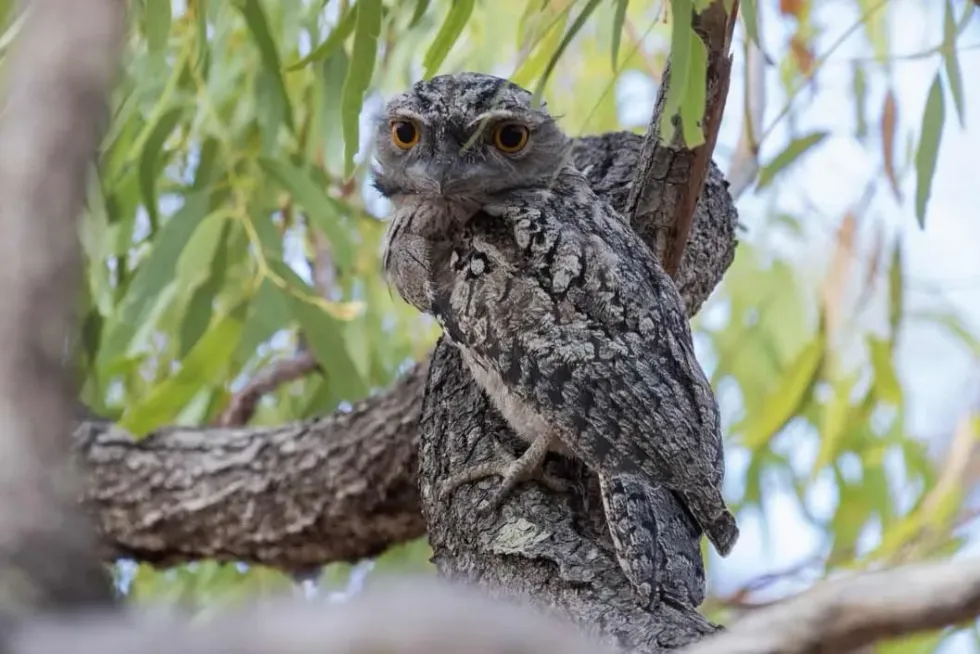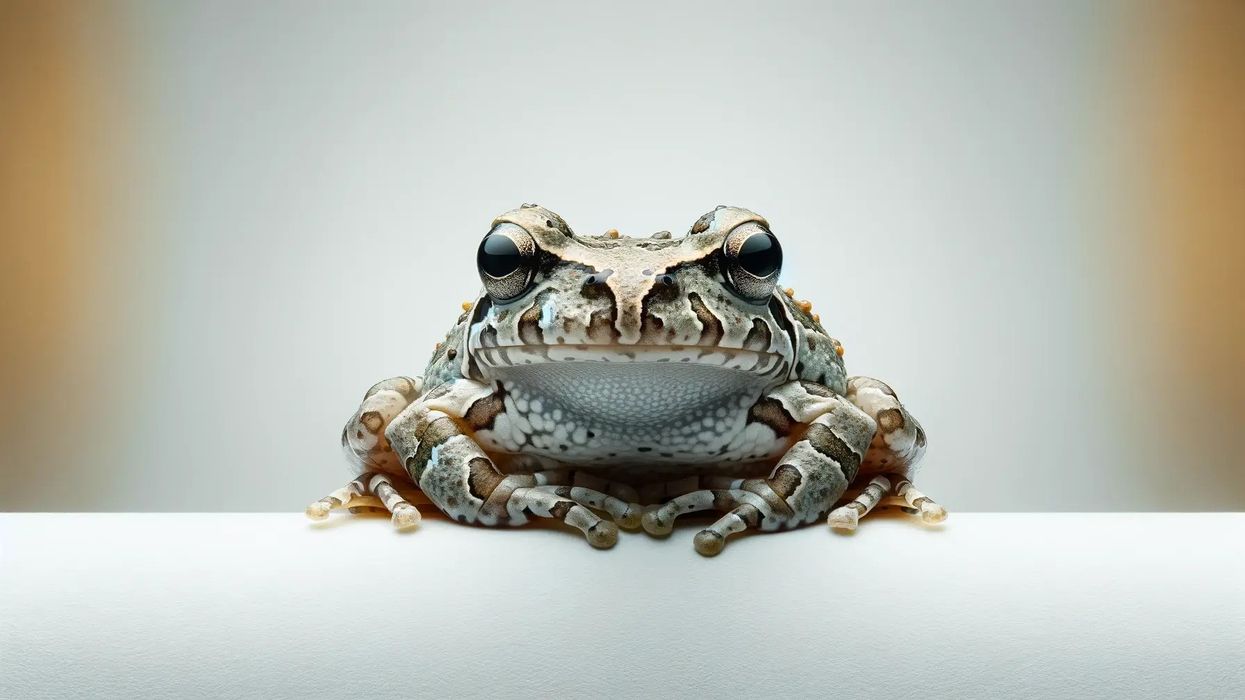A species of bird that are often mistaken for owls, the birds called tawny frogmouths are found throughout Australia. They're 13-21 in (34-53 cm) in length and, on average, weigh around 0.8 lb (350 g).
Though they look similar to them, unlike owls they don't possess curly talons at their feet, in fact, they actually have tiny, frail feet. Tawny frogmouths have soft feathers and stocky heads with big yellow eyes and stiff bristles surrounding their beak.
They have silvery-grey, black, and white patterned plumage that enables them to camouflage when sitting on a tree branch. Tawny frogmouths make low-frequency, soft buzzing sounds like that of a bee.
They can also produce hissing and clacking sounds with their beaks. During the breeding season, males and females perform duets simultaneously that consist of something known as 'call sequences'.
The two other species of tawny frogmouths found in Australia are marbled frogmouth and Papuan frogmouth.
Here, we have many amazing and interesting facts about tawny frogmouths that you will enjoy. Let's take a look at these tawny frogmouth owl facts and information, and if you enjoy these then, do read our tawny owl and hornbill facts.
Tawny Frogmouth Interesting Facts
What type of animal is a tawny frogmouth?
Tawny frogmouths are a species of frogmouth bird found in the Australian mainland and Tasmania.
What class of animal does a tawny frogmouth belong to?
Tawny frogmouths belong to the Aves class and are similar to owls in appearance.
How many tawny frogmouths are there in the world?
Tawny frogmouth birds are a common species, and their population is not quantified but, scientists believe that there are at least 10,000 mature individuals.
Where does a tawny frogmouth live?
Tawny frogmouths are known to be found in Australia and its various parts, such as Tasmania. They're quite common birds in that region and are sighted regularly.
What is a tawny frogmouth's habitat?
The tawny frogmouth bird has a variety of habitats. They're usually found in the rainforest margins, parks, alpine woods, and gardens. They prefer to live more in open woodlands.
Who do tawny frogmouths live with?
Tawny frogmouths are known to mate for life. Once they find their partner, these birds spend their whole life together and mate together each breeding season. They're so close that they often evict their children to live together.
How long does a tawny frogmouth live?
Tawny frogmouths have a lifespan of 14 years in the wild. They spend this time with a single mate only and are known to be committed to their mate. They do not change partners throughout their lives.
How do they reproduce?
Tawny frogmouths usually breed between the months of August to December, but it also depends on heavy rain areas. They build a nest and lay one to three eggs at a time and take care of the hatchling for around 25 to 35 days.
They look for old trees to build their nest as they can easily blend with the tree branch and guard their nest.
What is their conservation status?
Tawny frogmouths come under the category of Least Concern. That means they're not at all in danger and are quite common birds to see flying around in parks and gardens within Australia.
Tawny Frogmouth Fun Facts
What do tawny frogmouths look like?
Tawny frogmouth birds have a silver-grey plumage and black, white, and brownish patterned streaks and mottles that help them camouflage with the tree branch. They have large yellow eyes, short legs, rounded wings, and a large and wide olive-grey colored beak.
How cute are they?
Tawny frogmouths are common and are considered cute as they appear to be friendly and calm. Apart from appearing cute, they are quite useful as they are considered one of Australia's best pesticides as they eat mosquitoes, flies, moths, worms, and other vermin. As their beak is wide and front-facing, it helps them in easily catching their prey.
How do they communicate?
Tawny frogmouths generally use low-frequency sounds to communicate but once they get loud, you can hear their warning screams from miles away. They produce a soft warning buzz like a bee when startled and usually communicate in low "oom-oom-oom" sounds.
How big is a tawny frogmouth?
Tawny frogmouths (Podargus strigoides) are about 13-21 in (34-53 cm) in length and are really good at disguising themselves as tree branches; their body patterns resemble branches, helping these smart birds camouflage right into the tree.
How fast can a tawny frogmouth fly?
Despite being birds, tawny frogmouths are actually poor flyers. Because of this they often sit on a branch and wait for their prey to show up.
How much does a tawny frogmouth weigh?
Tawny frogmouths weigh around 0.3-1.2 lb (157-555 cm). While males weigh around 0.7 lb (354 g), females weigh around 0.6 lb (297 g).
What are the male and female names of the species?
The male and female species of tawny frogmouths do not have separate names. They're all commonly known by their scientific name, Podargus strigoides.
What would you call a baby tawny frogmouth?
A tawny frogmouth baby is known as a chick. Chicks develop half of their adult mass within 25 to 35 days after hatching. Till then, its parents take care of it and bring food to the hatchling.
What do they eat?
Tawny frogmouths prey on insects, worms, slugs and moths. They hide on a tree branch waiting to catch prey as it approaches the tree. They have a wide, forward-facing beak that can be used for catching insects. However, they've been known to be killed by vehicles whilst chasing insects.
Are they dangerous?
Tawny frogmouths have adapted to live along with humans, and they do not get aggressive until other males try to intrude on their nest. There have been reports of tawny frogmouth nest in parks and gardens, so they are generally good with humans.
Would they make a good pet?
Even though tawny frogmouths have adapted to human presence, it is forbidden to keep a tawny frogmouth as a pet in Australia. You can only keep them for rehabilitation, which requires a special permit, and after treatment, they have to be released back into the wild.
Did you know...
Tawny frogmouths are really good at regulating the water levels of their body. They do not drink water as they get enough water from their food. Apart from small insects, they also prey on frogs, reptiles, and small mammals.
Until a hatchling grows enough to leave the nest on its own, the parent birds feed them necessary food such as small rodents and reptiles.
Even though tawny frogmouths look a lot like owls, they're more closely related to oilbirds and potoos.
Noises of the tawny frogmouth
Tawny frogmouths usually make a low-frequency sound to communicate. They produce a soft buzz like a bee when startled but they also make a really loud noise that can be easily heard from miles away when they feel danger and want to fend off their opponent.
They produce an " oom-oom-oom" sound at night, usually at a frequency of eight calls per five seconds. Males and females are also known to perform duets simultaneously. They also perform call sequences before and during their breeding season.
Symbolism of the tawny frogmouth
Tawny frogmouths represent the idea of synchronicity. When you see a tawny frogmouth, it shows us that the universe works in a sense of harmony even if it looks like everything is going into chaos.
Here at Kidadl, we have carefully created lots of interesting family-friendly animal facts for everyone to discover! Learn more about some other birds including the pileated woodpecker, or chinstrap penguin.
You can even occupy yourself at home by drawing one of our tawny frogmouth coloring pages.










